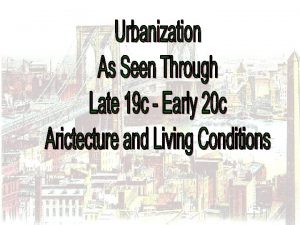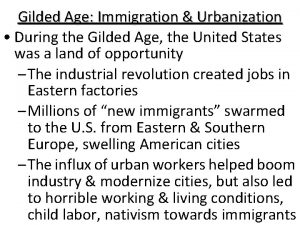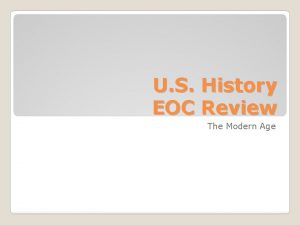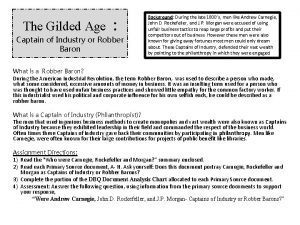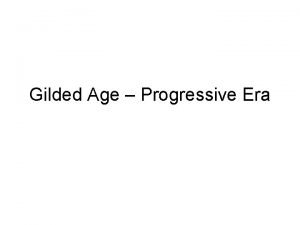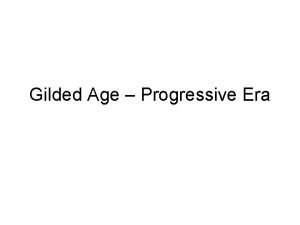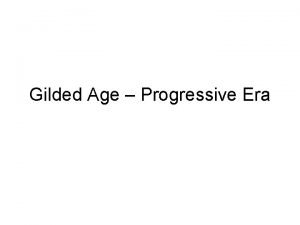The Gilded Age INDUSTRIALIZATION Industrialization Industrialization Read pp








- Slides: 8

The Gilded Age INDUSTRIALIZATION

Industrialization

Industrialization § Read pp. 63 -66 in Jarrett Textbook § Take notes as you read each subsection: § § § Technological Innovations Growth of Railroads Development of a National Market The Impact of Population Growth New Types of Business Organization § After the notes for each subsection, write a ONE SENTENCE summary for each subsection § Write down any questions you have about what you read. § Raise your hand when you are done.

The Industrialists plus One § Before Bill Gates, Steve Jobs, Mark Cuban, Jerry Jones, Oprah Winfrey, Michael Jordan, Donald Trump, Martha Stewart, Russell Simmons, Jay-Z, Beyonce, or Sean Combs there was …… § Cornelius Vanderbilt § John D. Rockefeller § Andrew Carnegie § JP Morgan § Which man is NOT an Industrialist? Rank them. Justify the #1 “Industrialist”

The Pros and Cons of Big Business § PROS § More Efficient which leads to lower prices § Hire more workers § Produce more § Can invest in research and innovation § CONS § Unfair advantage over smaller businesses § Sometimes exploit workers § Less concerned with pollution § Unfair influence over government policies affecting them

The Theory of Laissez-Faire § Means: “Let it be” or “Leave it alone” § In Business it means: The government should do very little regulating of businesses or the market § GOVERNMENTS SHOULD: § Protect Property and Enforce Contracts § Establish a system of patents § Enact Tariffs to help manufacturers § Some believed that the Constitution did not give the government the right to regulate business § Some business practices became “Anti-Competitive” so a few laws were created to regulate businesses § Interstate Commerce Act (1887): created to regulate railroad business practices § Sherman Anti-Trust Act (1890): made “unnatural” monopolies (trusts) illegal

Conditions of Labor § Long Hours and Low Wages § 10 -14 hours, 6 days a week § $3 -$12 a week § Immigrants, Women, and Children would work for less § Poor Conditions, Boring, and Repetitive § Less-Skilled Work, anyone could do it § Hazardous. Thousands were injured or killed on the job each year § Read the “Sweatshop” poem on pg. 71. How does the worker feel about his job? § Child Labor § Lack of Security § Workers could be fired at any time for any reason § No unemployment pay like today § No worker’s compensation when injured at work like today

The Rise of Labor Unions § Labor Union: workers who “unite” to act as one group when negotiating with their employer. § One tactic of a Labor Union is to “STRIKE”: stop working until conditions improve § Early Examples: § Knights of Labor § Unskilled and Skilled workers § Wanted 8 hour work day, no child labor, equal pay for women, restrictions on immigrants § American Federation of Labor § Founded by Samuel Gompers § Skilled workers only (carpenters, brick masons, cigar makers, etc. ) § Wanted higher pay, 8 hour work day, better conditions § Government Attitude Toward Labor Unions § Most Government Leaders supported Businesses, not workers § Campaign Donations § Protect economy from worker strikes § Public opinion favored businesses, not workers



